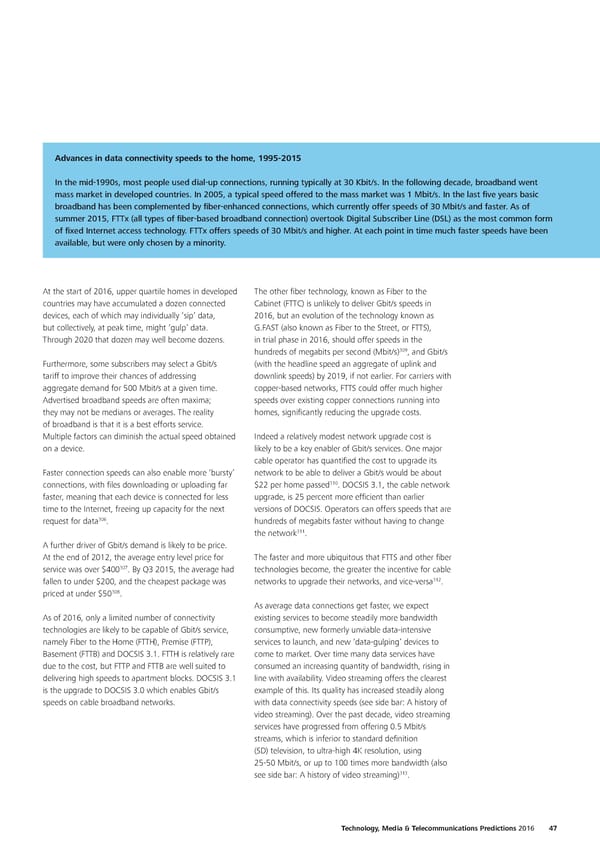Advances in data connectivity speeds to the home, 1995‑2015 In the mid-1990s, most people used dial-up connections, running typically at 30 Kbit/s. In the following decade, broadband went mass market in developed countries. In 2005, a typical speed offered to the mass market was 1 Mbit/s. In the last five years basic broadband has been complemented by fiber-enhanced connections, which currently offer speeds of 30 Mbit/s and faster. As of summer 2015, FTTx (all types of fiber-based broadband connection) overtook Digital Subscriber Line (DSL) as the most common form of fixed Internet access technology. FTTx offers speeds of 30 Mbit/s and higher. At each point in time much faster speeds have been available, but were only chosen by a minority. At the start of 2016, upper quartile homes in developed The other fiber technology, known as Fiber to the countries may have accumulated a dozen connected Cabinet (FTTC) is unlikely to deliver Gbit/s speeds in devices, each of which may individually ‘sip’ data, 2016, but an evolution of the technology known as but collectively, at peak time, might ‘gulp’ data. G.FAST (also known as Fiber to the Street, or FTTS), Through 2020 that dozen may well become dozens. in trial phase in 2016, should offer speeds in the 309 hundreds of megabits per second (Mbit/s) , and Gbit/s Furthermore, some subscribers may select a Gbit/s (with the headline speed an aggregate of uplink and tariff to improve their chances of addressing downlink speeds) by 2019, if not earlier. For carriers with aggregate demand for 500 Mbit/s at a given time. copper-based networks, FTTS could offer much higher Advertised broadband speeds are often maxima; speeds over existing copper connections running into they may not be medians or averages. The reality homes, significantly reducing the upgrade costs. of broadband is that it is a best efforts service. Multiple factors can diminish the actual speed obtained Indeed a relatively modest network upgrade cost is on a device. likely to be a key enabler of Gbit/s services. One major cable operator has quantified the cost to upgrade its Faster connection speeds can also enable more ‘bursty’ network to be able to deliver a Gbit/s would be about 310 connections, with files downloading or uploading far $22 per home passed . DOCSIS 3.1, the cable network faster, meaning that each device is connected for less upgrade, is 25 percent more efficient than earlier time to the Internet, freeing up capacity for the next versions of DOCSIS. Operators can offers speeds that are 306 request for data . hundreds of megabits faster without having to change 311 the network . A further driver of Gbit/s demand is likely to be price. At the end of 2012, the average entry level price for The faster and more ubiquitous that FTTS and other fiber 307 service was over $400 . By Q3 2015, the average had technologies become, the greater the incentive for cable 312 fallen to under $200, and the cheapest package was networks to upgrade their networks, and vice-versa . 308 priced at under $50 . As average data connections get faster, we expect As of 2016, only a limited number of connectivity existing services to become steadily more bandwidth technologies are likely to be capable of Gbit/s service, consumptive, new formerly unviable data-intensive namely Fiber to the Home (FTTH), Premise (FTTP), services to launch, and new ‘data-gulping’ devices to Basement (FTTB) and DOCSIS 3.1. FTTH is relatively rare come to market. Over time many data services have due to the cost, but FTTP and FTTB are well suited to consumed an increasing quantity of bandwidth, rising in delivering high speeds to apartment blocks. DOCSIS 3.1 line with availability. Video streaming offers the clearest is the upgrade to DOCSIS 3.0 which enables Gbit/s example of this. Its quality has increased steadily along speeds on cable broadband networks. with data connectivity speeds (see side bar: A history of video streaming). Over the past decade, video streaming services have progressed from offering 0.5 Mbit/s streams, which is inferior to standard definition (SD) television, to ultra-high 4K resolution, using 25-50 Mbit/s, or up to 100 times more bandwidth (also 313 see side bar: A history of video streaming) . Technology, Media & Telecommunications Predictions 2016 47
 Technology, Media & Telecommunications Predictions Page 55 Page 57
Technology, Media & Telecommunications Predictions Page 55 Page 57